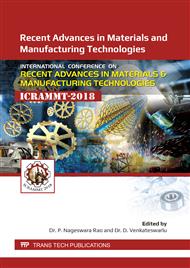p.355
p.361
p.367
p.373
p.380
p.386
p.392
p.398
p.404
Synthesis and Evaluation of Biocompatibility of Cu-Al-Mn Shape Memory Alloy
Abstract:
In recent days, it is being found that shape memory alloys can be used in the medicinal field which helps to alleviate numerous disabilities in people. The Shape memory alloy are evaluated for biocompatibility in present work. The objective is to determine the biocompatibility of Cu-Al-Mn SMAs using the alloy of composition 10-14 weight. % Aluminium (Al), 5-9 weight% Manganese (Mn) and rest copper (Cu) through ingot metallurgy in a constrained atmosphere. The casted samples were homogenisation at 900°C for one and half hours and then rolled at 900°C. The rolled specimens were betatized for half an hour at 900°C followed by Step quenching in boiling water (100°C) and quenching in water at room temperature (30°C). They are cut to the dimension of 10 mm * 10mm * 1mm (breadth*length*height) and then effect of shape memory on obtained alloy was assessed. In continuation, in order to understand the biocompatibility of obtained alloy, the samples were analysed for antibacterial movement by turbido-metric process. The microorganisms utilized for biocompatibility are S.aureus and E.coli. The outcomes showed remarkable biocompatibility with the inference that it can be employed for invitrouses.
Info:
Periodical:
Pages:
380-385
Citation:
Online since:
August 2019
Keywords:
Price:
Сopyright:
© 2019 Trans Tech Publications Ltd. All Rights Reserved
Share:
Citation:


